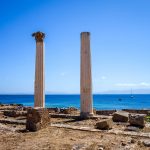Over the centuries, Rabbi Shimon bar Yohai’s grave on Mount Meron has drawn pilgrims in increasing numbers, peaking with both celebrations and controversy on the anniversary of his death. The pre-state procession of musicians and mystics from Safed to Meron
Mount Meron has been a “tourist attraction” since at least the 1100s, when it began appearing in Jewish travelogues as the final resting place of Hillel and Shammai. In the cave associated with the graves of the rival Mishnaic giants, a hollow stone was said to miraculously fill with water.
Every year on 14 Iyar, a ceremony was held onsite to celebrate this gift. Both local Jews and Arabs took part, along with Jewish pilgrims from neighboring lands. In times of drought, the Jews of Safed practiced rituals in the cave while fasting and praying for rain, and the subsequent appearance of moisture on the stone was seen as a good sign.

In the mid-16th century, at Safed’s height as a center of Jewish learning and mysticism, attention shifted from the burial cave of Hillel and Shammai to a nearby cleft where Rabbi Shimon bar Yohai (or Rashbi for short) and his son Elazar were supposedly buried. Here the yearly celebration, or hillula (day of rejoicing), marking Rashbi’s death was held on 18 Iyar, also known as Lag Ba-Omer, the thirty-third day of the counting of the Omer. The high point of the proceedings was the kindling of a huge bonfire. Three-year-old boys received their first haircut on this occasion, usually shaving all but their dangling earlocks.
In Nebi Samuel, identified since medieval times as the burial place of the biblical Samuel, similar festivities long took place on the traditional date of the prophet’s death – 28 Iyar. These gatherings may have moved to Meron around 1570, after the conquering Ottomans forbade Jews to congregate at Nebi Samuel (for fear of forbidden alcohol consumption at a Muslim holy site). Others claim the rituals surrounding Rashbi’s grave predate the Ottoman decree.
The Journey
According to the Zohar, Rashbi revealed its mystical secrets to his disciples on the day he departed this world. Hence the customary celebration of his passing, which spread to both Oriental and Hasidic communities. Over time, the date was marked with special prayers, rejoicing, and meditations. Yet certain rabbis and kabbalists from Safed objected to these practices. In the late Ottoman period, some critics even denounced them as a stepping stone to idol worship:
Not for nothing is this festival, whose origins lie who knows where, called a hillula, for truly it’s just hooliganism and utterly foreign to the spirit of Israel and its laws, which have kept the living at a distance from the dead […]. The Holy One Blessed Be He hid the grave of Moses our teacher, may he rest in peace, from all eyes. Why? For fear of gaieties such as these, which eventually lead to paganism. (Yehiel Mihel Pines, “Seven Weeks in the Galilee,” Ha-zevi, 14 Marheshvan 5646/October 23, 1885, p. 15)







